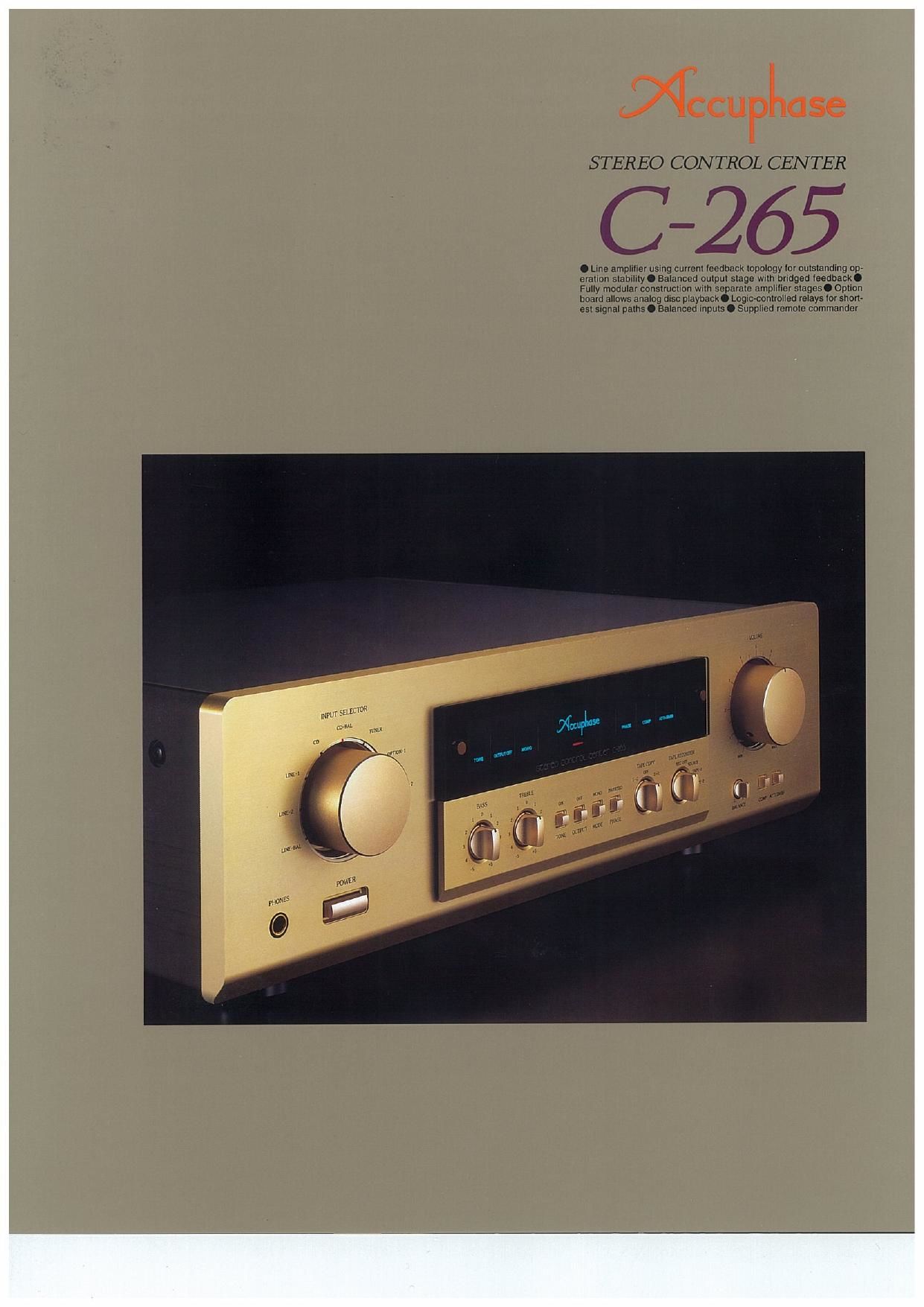Accuphase C 265 Brochure
This is the 4 pages manual for Accuphase C 265 Brochure.
Read or download the pdf for free.
If you want to contribute, please mail your pdfs to info@audioservicemanuals.com.

Extracted text from Accuphase C 265 Brochure (Ocr-read)
Page 2
A new type of preamplifier using balanced signal transmissin. The line am-
plifier stage features current feedback topology for superior sound and total
operation stability. Dedicated power transformers for left and right chan-
nels and full mono construction with physically separate amplifier modules.
Option board allows analog disc reproduction with superb sound quality.
The 0265 is a stereo control center designed for
impeccable sound quality. It incorporates a wealth
of prestigious Accuphase technology, such as bal-
anced signal transmission and current feedback
line amplifier stages. In its standard configuration,
the 0-265 offers a versatile array of line-level in-
puts, but by installing the optional analog disc
board in a dedicated slot on the rear panel, it also
offers outstanding analog disc reproduction.
In order to bring out the best in program sources
and to extract the full sonic potential of the power
amplifier, a preamplifier must faithfully transmit the
music signal without deterioration or addition of
any form of coloration.
The 0-265 achieves this task admirably. thanks to
its balanced circuit topology that reliably eliminates
all noise, The output stage is especially notewor-
thy for its symmetrically bridged feedback, which
results in a floating design where the signal is kept
entirely separate from the ground line, The line
amplifiers are based on the current feedback prin-
ciple which has proven its sonic excellence in many
top-grade components from Accuphase. This prin~
ciple virtually eliminates phase shifts in the upper
frequency range, Frequency response is not af-
fected by gain, and only small amounts of nega-
tive feedback are required. This allows the phase
compensation circuitry to be kept simple. thus
assuring superb transient response.
The 0-265 employs modular construction using
sturdy enclosures made from extruded aluminum.
This design provides electrical insulation and pro-
tects the amplifier against vibrations and other
adverse mechanical influences. Not only the unit
amplifiers, but also the power transformers and
filtering capacitors are kept separate for the left
and right channels. This dual mono configuration
precludes any possibility of unwanted electrical in-
teraction, Tone controls and a loudness compen~
sator allow sonic touch-ups. Balanced inputs and
logical relays ensure extremely short and highly
pure signal paths. The 0-265 offers a perfect blend
of sound quality and performance at the highest
level.
Current Feedback Topology in Line Amplifiers
Prevents Phase Shifts
in order to improve the characteristics of an am-
plifier, a commonly employed technique called
negative feedback (NFB) routes part of the output
Fig. 2 Current feedback amplifier principle
signal back to the input. Conventional amplifiers
employ voltage NFB. but the 0-265 uses the sig-
nal current rather than the voltage for feedback.
Figure 2 shows the operating principle of this cir-
cuit. At the sensing point of the feedback loop,
current detection with low impedance is per-
formed. A trans-impedance amplifier then converts
the current into a
voltage to be
used as the feed-
back signal.
Since the imped-
ance at the cur~
rent feedback
point (current -
adder in Fig 2) is W3 mewimwrmtlmm
verylow,thereis I WWWMWW 9)
almost no phase shift. Phase compensation there-
fore can be kept at a minimum, resulting in excel-
lent transient response and natural energy balance.
Figure 3 shows the frequency response for differ-
ent gain settings of the current feedback ampli-
fier. With this circuit, there is virtually no change in
frequency response when gain is altered, and the
response remains uniform over a wide range.
Balanced Output Stage with Bridged Feedback
In balanced signal transmission, two identical sig-
nals are transmitted simultaneously with inverted
phase and combined at the receiving end, thereby
mm©-
w©-'§
mas-é
3
mez©-§
§
Fig. 1 Block diagram of C- 265 (one channel)
canceling out
common-mode ~ W
noise and inter-
ferencet This
assures pure "3 1 1
high»quality ,
signal trans- W A"
mission. The "t
principle of bal-
Fig.4 Balanced output amplifier clrcult
a n c e d s o u n d
diagram (one channel )
transmission is
shown in Figure 4. The outputs of the two amplifi-
ers AMP1 and AMP2 are connected to form a
cross-feedback loop, which sends the symmetri-
cal (+) and (-) signals with low impedance to the
next stage. The signals are isolated from the
ground line. resulting in an ideal balanced circuit.
Even if one side of the output is grounded, both
amplifiers continue to operate, and the output volt-
age does not change.
Discrete Line Amplifier Designed for Sound
Quality
0 44$ .. ..
m arm
n l
m
m
in
fl
Flg.5 Llna Amplifier clrcult ( one channel)
The line amplifier (Fig. 5) is a pure complementary
push-pull circuit built from discrete components
and employing current feedback. Phase compen-
sation can be kept to a minimum, resulting in life-
like ambience. A balanced input stage with gain is
located directly before the volume control, followed
by the line amplifier, This assures outstanding sig-
nal-to-noise ratio also at low listening levelst
Fully Modular Construction
The 0-265 contains a total of six separate mod-
ules comprising the
balanced input am-
plifiers, line amplifi-
ers, and balanced
output amplifiers
for each channel,
M o u n t e d o n a
massive chassis . . , .
made of extruded aluminum. the modules provide
optimum operating conditions for each circuit seg-
ment and reliably shut out external vibrations.
Separate Transformers for Left and Right chan-
nels and Dedicated Power Supply Circuits for
Each Unit Amplifier
Two completely separate sets of transformers and
filtering capacitors are provided, to preclude any
possibility of electrical interaction between the